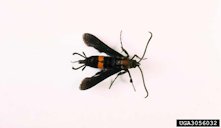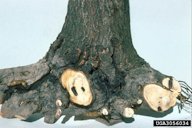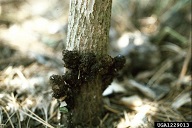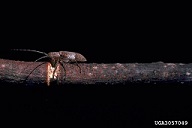| Persimmon Pests | ||||||||||||||
|---|---|---|---|---|---|---|---|---|---|---|---|---|---|---|
|
Back
to Persimmon Page 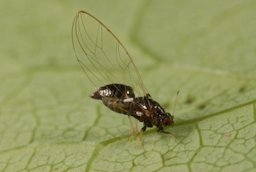 Fig. 1  Adult persimmon psylla Trioza diospyri (Ashmead) 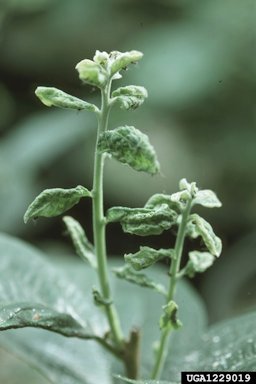 Fig. 2  Damage to common persimmon, D. virginiana, caused by infestation of the persimmon psylla, T. diospyri (Ashmead) 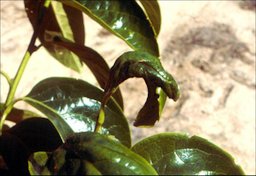 Fig. 3  Central rolled leaf shows the damage from the persimmon psylla 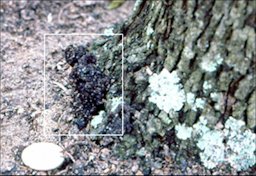 Fig. 4  Persimmon borer pupal case protruding from the root  Fig. 5  The persimmon borer larva  Fig. 10  Adult twig girdler and damage
|
The
persimmon rootstock is native American persimmon and the scion is
Japanese. A few insect pests that attack the rootstock are familiar,
those on the scion are often new. Persimmon is a subtropical fruit,
growing across a wide range of environments that can be very different
from year to year. On the limits of the range and under extremes of
temperature the plant will be stressed. Stress will change the
persimmon's susceptibility to pests, particularly borers. Also, species
of pests will be different in different parts of the growing range:
south Florida may have fruit flies as fruit pests, etc. 2 Scales Scale, persimmon psylla, twig girdlers and borers attack the tree or leaves while plant and stink bugs may attack the fruit. Scales, predominantly white peach scale, attack the wood on the branches and trunk. Small infestations may be removed by pruning, larger infestations should be treated with a dormant or summer oil or with a conventional pesticide during the growing season targeted to the crawler stage of the scale. Two applications 7-14 days apart may be necessary to control large infestations. Small infestations may be removed by pruning. 2 Persimmon psylla Trioza diospyri (Ashmead) Persimmon psylla is the primary leaf pest and is found attacking newly forming leaves in spring. Infested leaves appear crinkled and malformed (Fig. 3). The white powdery covered nymphs and black bodied adults are found feeding inside the mishapen leaves which makes control difficult. Psylla infestations stunt the growth of shoots on young trees. Control with conventional pesticides should be timed to the bloom stage. 2 Persimmon clearwing borer Sannina uroceriformis Walker The persimmon borer, Sannina uroceriformis Walker, (Lepidoptera: Sesiidae) attacks the American persimmon, Diospyros virginiana, which is its only known host. The persimmon borer is a pest because the native, American persimmon is used as the rootstock for the fruit-producing scions of the Japanese persimmon, D. kaki. This clearwing moth is found attacking native persimmon throughout the range of its host along the Atlantic Coast from New Jersey to Florida, and westward to Texas, Oklahoma, Missouri, Kansas, Ohio, and Indiana. 1 Several species of wood-boring insects may attack the roots, trunk and branches of persimmon. Persimmon clearwing borer is a native pest of the American rootstock. The adult moth emerges in early spring and has one generation per year. Pupal cases left by emerging adults can be found at the base of the tree near the root crown (Fig. 4). 2
Fig. 6. The adult female persimmon clearwing moth Fig. 7. The adult male persimmon clearwing moth Fig. 8. Damage to persimmon by the persimmon borer Fig. 9. The pupal case of the persimmon borer Further Reading Bothryosphaeria dothidea, Forest Pest Species Profile FAO pdf The Persimmon Borer, Sannina uroceriformis Walker, University of Florida pdf (Archived) Twig girdlers Oncideres cingulata Twig girdlers attack persimmon and a variety of tree species most notably hickory and pecan. During September and October the adult female deposits her eggs by piercing the bark below the buds on terminal twigs. After oviposition the female girdles the stem which may later fall to the ground. In so doing the beetle may transmit the wilt disease Cephalosporium diospyri. Infested twigs should be gathered and destroyed. 2
Fig. 11. Adult twig girdler and damage to twig (note shape and position of head) Fig. 12. Adult twig girdler and damage Further Reading Insect Management in Oriental Persimmon, University of Florida pdf (Archived) |
|||||||||||||
| Bibliography 1 Mizell, Russell F. lll. "The Persimmon Borer Sannina uroceriformis Walker, Pest of Persimmon." Entomology and Nematology Dept., UF/IFAS Extension, ENY-835, Original pub. July 2006, Revised Jan. 2019, Archived, AskIFAS, edis.ifas.ufl.edu/in669. Accessed 22 Dec. 2016, 4 Sept. 2020, 4Jan. 2024. 2 Mizell, Russell F. lll, and Gary Brinen. "Insect Management in Oriental Persimmon." Entomology and Nematology Dept., UF/IFAS Extension, ENY-803, Original pub. Oct. 1993, Revised Aug. 2001, May 2005, Reviewed Jan. 2015, Archived, AskIFAS, edis.ifas.ufl.edu/ig096. Accessed 25 Apr. 2017, 4 Jan. 2024. Photographs Fig. 1 Buss, Lyle. "Adult Persimon Psylla, Trioza diopyri (Ashmead)." UF/IFAS Extension, AskIFAS, edis.ifas.ufl.edu. Accessed 22 Dec. 2016. Fig. 2 Payne, Jerry A. "Persimmon psylla (Trioza diospyri) (Ashmead), foliage." USDA Agricultural Research Service, 2003, Bugwood.org, (CC BY 3.0 US), bugwood.org. Accessed 22 Dec. 2016. Fig. 3 "Central rolled leaf shows the damage from the persimmon psylla." UF/IFAS Extension, AskIFAS, edis.ifas.ufl.edu. Accessed 22 Dec. 2016. Fig. 4 "Persimmon borer pupal case protruding from the root." UF/IFAS Extension, AskIFAS, edis.ifas.ufl.edu. Accessed 22 Dec. 2016. Solomon, James. The persimmon borer larva. USDA Forest Service. insectimages.org Fig. 5 Solomon, James. "The persimmon borer larva." USDA Forest Service, 2010, Bugwood.org, bugwood.org. Accessed 22 Dec. 2016. Fig. 6 Solomon, James. "The Adult Female Persimmon Clearwing Moth." USDA Forest Service, 2010, Bugwood.org, bugwood.org. Accessed 22 Dec. 2016. Fig. 7 Solomon, James. "The Adult Male Persimmon Clearwing Moth." USDA Forest Service, 2010, Bugwood.org, bugwood.org. Accessed 22 Dec. 2016. Fig. 8 Solomon, James. "Damage to persimmon by the persimmon borer." USDA Forest Service, 2010, Bugwood.org, bugwood.org. Accessed 22 Dec. 2016. Fig. 9 Payne, Jerry A. "The pupal case of the persimmon borer." USDA Forest Service, Bugwood.org, bugwood.org. Accessed 22 Dec. 2016. Fig. 10 "Twig girdler (Oncideres cingulata)." Clemson University, USDA Cooperative Extension Slide Series, Uploaded July 23, 2003, Updated May 9, 2011, (CC BY 3.0 US), www.insectimages.org/browse/detail.cfm?imgnum=1235223. Accessed 11 Nov. 2018. Fig. 11 Solomon, James. "Twig girdler (Oncideres cingulata) and damage - adult girdling twig (note shape and position of head)." USDA Forest Service, Uploaded April 28, 1999, Updated May 9, 2011, Bugwood.org, (CC BY 3.0 US), www.insectimages.org/browse/detail.cfm?imgnum=3057049. Accessed 10 Nov. 2018. Fig. 12 Solomon, James. "Twig girdler (Oncideres cingulata) damage." USDA Forest Service, Uploaded April 28, 1999, Updated June 4, 2001, Bugwood.org, (CC BY 3.0 US), www.insectimages.org/browse/detail.cfm?imgnum=3046013. Accessed 11 Nov. 2018. Published 22 Dec. 2016 LR. Last update 4 Jan. 2024 LR |
||||||||||||||

